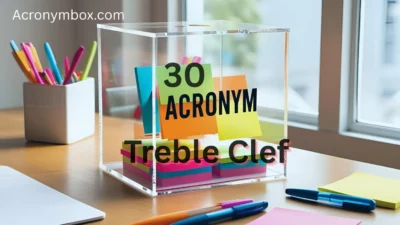We’ve all hit that awkward pause before saying an acronym out loud:
“Is it a FAQ or an FAQ?”
A NASA scientist or an NBA player?
The answer lies not in spelling, but in sound.
This guide will break down the simple (but often overlooked) rule of choosing “a” vs. “an” before an acronym. Then, we’ll go through 30 common acronyms, explaining whether to use “a” or “an” before each one—and why, with quick example sentences and practical tips.
By the end, you’ll have a confident grip on how to handle acronyms smoothly in speech and writing.
📚 What’s the Rule: “A” vs. “An” Before Acronyms
Here’s the golden rule:
Use “an” if the acronym starts with a vowel sound (not just a vowel letter).
Use “a” if the acronym starts with a consonant sound.
It’s all about how it sounds out loud—not how it looks on the page.
✅ Examples:
- ✅ An MBA (starts with the vowel sound “em”)
- ✅ A URL (starts with the “y” sound in “you”)
🔠 30 Acronyms: Use “A” or “An”? (+ Examples & Usage)
Let’s explore 30 everyday acronyms and whether they take “a” or “an,” with helpful explanations.
1. FAQ
✅ A FAQ
Why: Starts with “F” = consonant sound “eff.”
Example: Let’s add a FAQ section to the website.
2. MBA
✅ An MBA
Why: “M” sounds like “em,” a vowel sound.
Example: She’s earning an MBA from Stanford.
3. URL
✅ A URL
Why: “U” sounds like “you,” a consonant sound.
Example: Paste a URL into the search bar.
4. HTML
✅ An HTML
Why: “H” sounds like “aitch,” which starts with a vowel sound.
Example: He wrote an HTML template for the site.
5. NSA
✅ An NSA
Why: “N” sounds like “en,” a vowel sound.
Example: He worked as an NSA analyst.
6. PDF
✅ A PDF
Why: “P” starts with a consonant sound “pee.”
Example: Please send a PDF copy of your resume.
7. API
✅ An API
Why: “A” sounds like the letter “ay” – a vowel sound.
Example: We connected to an API for weather data.
8. ATM
✅ An ATM
Why: “A” sounds like “ay” – vowel sound.
Example: I need to find an ATM nearby.
9. USB
✅ A USB
Why: “U” sounds like “you.”
Example: Grab a USB drive from my desk.
10. AI
✅ An AI
Why: “A” is a vowel sound.
Example: That company is building an AI chatbot.
11. VPN
✅ A VPN
Why: “V” is a consonant sound.
Example: You should use a VPN for security.
12. ID
✅ An ID
Why: “I” is a vowel sound (“eye”).
Example: Please show an ID at the door.
13. QR Code
✅ A QR code
Why: “Q” is a consonant sound (“cue”).
Example: Scan a QR code to pay.
14. IoT
✅ An IoT
Why: Starts with “I” = “eye” = vowel sound.
Example: We’re launching an IoT device.
15. NGO
✅ An NGO
Why: “N” sounds like “en” = vowel.
Example: She volunteers with an NGO overseas.
16. GPS
✅ A GPS
Why: “G” is a consonant sound.
Example: Let’s use a GPS to find it.
17. SQL
✅ Depends:
- “A SQL” if pronounced “sequel”
- “An SQL” if pronounced “ess-cue-ell”
Example: He wrote a SQL query (or an SQL query, depending on pronunciation).
18. NBA
✅ An NBA
Why: “N” = “en,” a vowel sound.
Example: He dreams of being an NBA star.
19. CPU
✅ A CPU
Why: “C” = “see,” consonant sound.
Example: Your computer has a powerful CPU.
20. XML
✅ An XML
Why: “X” = “eks,” vowel sound.
Example: He created an XML schema.
21. HR
✅ An HR
Why: “H” = “aitch,” vowel sound.
Example: Talk to an HR rep about the issue.
22. CEO
✅ A CEO
Why: “C” = “see,” consonant sound.
Example: She’s a CEO with a bold vision.
23. IRS
✅ An IRS
Why: “I” = “eye,” vowel sound.
Example: He received an IRS notice.
24. TED Talk
✅ A TED Talk
Why: “T” is a consonant sound.
Example: He gave a TED Talk on climate change.
25. API Key
✅ An API key
Why: “A” = vowel sound.
Example: You need an API key to access that.
26. EU
✅ A EU (yes, really!)
Why: “E” sounds like “you,” which starts with a consonant sound.
Example: It’s a EU regulation.
✅ But in British English, many still prefer “an EU” due to differing pronunciation standards.
27. ISBN
✅ An ISBN
Why: “I” = “eye,” vowel sound.
Example: Look for an ISBN on the back cover.
28. NFC
✅ An NFC
Why: “N” = “en,” vowel sound.
Example: That phone supports an NFC connection.
29. UX
✅ A UX
Why: “U” sounds like “you.”
Example: She’s a UX designer.
30. OTP
✅ An OTP
Why: “O” = “oh,” a vowel sound.
Example: Enter an OTP to verify your login.
🎯 How to Choose the Right Article for Acronyms
Here’s your cheat-sheet logic:
| Starts With Sound | Use |
| Vowel sound (A, E, I, O, U) | an |
| Consonant sound (F, Y, C, S, etc.) | a |
Pro Tip:
Say it out loud. If your tongue wants to glide into the acronym with a soft vowel flow, go with “an.” If it feels crisp and sharp, “a” is likely correct.
🌍 Cultural and Regional Considerations
- In British English, some acronyms (like EU) lean more toward “an EU” due to how it’s pronounced across the pond.
- In American English, pronunciation tends to favor “a EU,” since “E” begins with a “y” sound (as in “you”).
✍️ Final Thoughts
“A vs. an before acronyms” might seem like a tiny thing, but it’s one of those details that polishes your writing and makes your speech more fluent. Remember—it’s about sound, not spelling.
So next time you hesitate, just read it out loud:
“Does it start with a vowel sound?”
If yes—an.
If not—a.
Simple, clean, confident.




